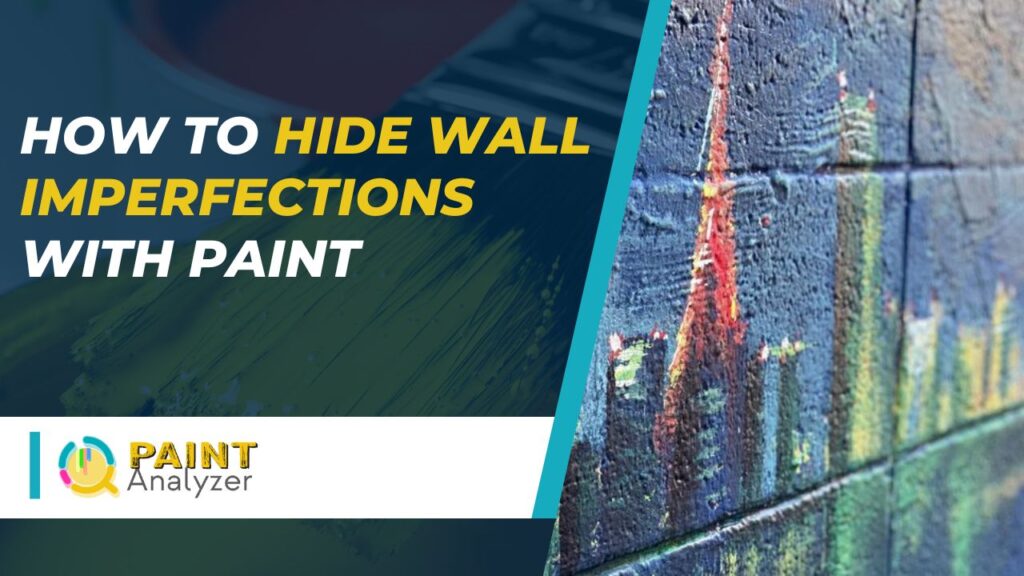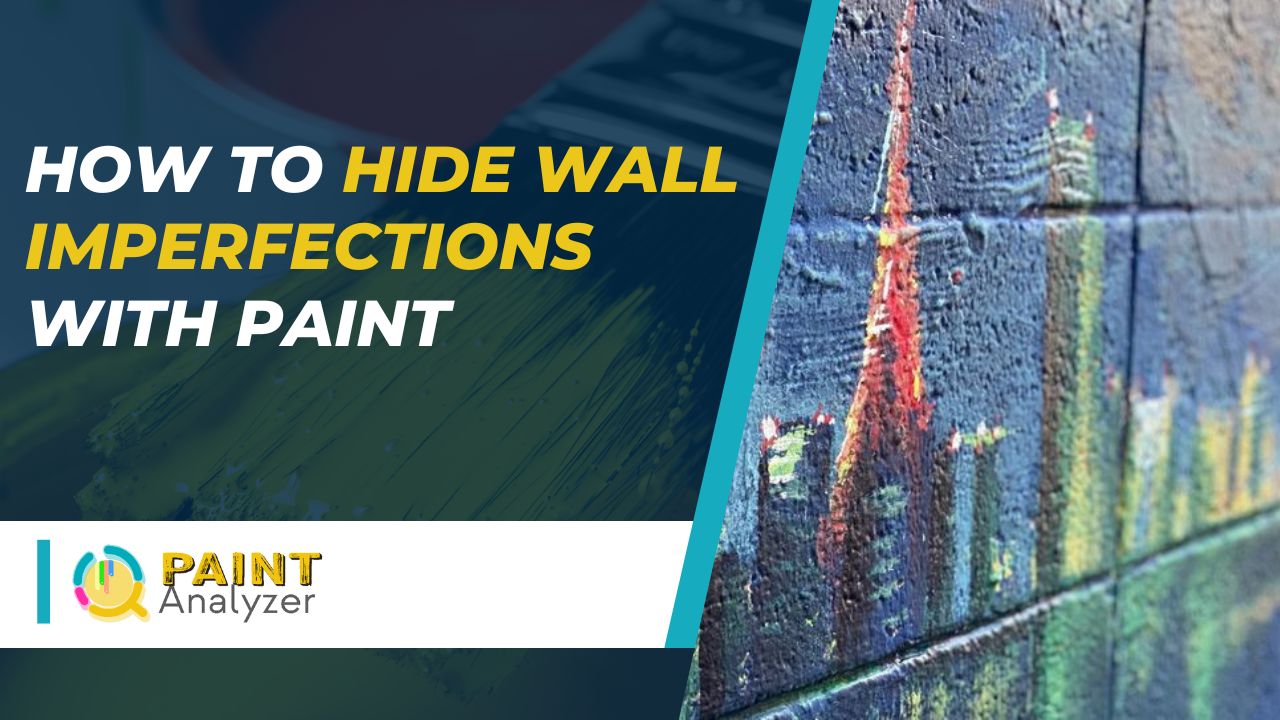Walls will inevitably develop imperfections over time. Whether from nails being hammered into the drywall or simply from everyday wear and tear, these imperfections can be unsightly and difficult to fix. However, there is a simple solution that can help to hide these imperfections.
With a little bit of Paint with a flat finish, you can easily cover up any wall imperfections, giving your walls a fresh, new look. Plus, painting is a relatively inexpensive way to update the look of your home.
So, if you’re looking for a quick and easy way to cover up those imperfections, grab a paintbrush and get to work!

How to Hide Wall Imperfections With Paint? A step-by-step guide
Painting is a great way to hide wall imperfections and give your space a fresh look, whether you’re dealing with cracks, dents, or other imperfections.
But before you start painting, you should do a few things to prep your walls and ensure a smooth, professional-looking finish. Here’s a step-by-step guide to prepping and painting your walls to hide imperfections:
Step 1: Prepare the surface
Wash the wall with a TSP solution to remove any dirt or grease. Rinse the wall with clean water and let it dry. Fill any holes or cracks with spackling compound and let it dry.
Step 2: Apply the primer
Applying a good quality primer to the wall before painting is vital, as this will ensure a better finish. If you use a paint + primer in one product, skip this step. However, if you use a separate primer, apply it evenly and carefully to avoid any paint problems later on.
Step 3: Paint the wall
To paint a wall evenly, use a paintbrush for smaller areas and a roller for larger areas. Make sure to apply the Paint to the wall in long strokes evenly. Allow the Paint to dry thoroughly before moving on.
Step 4: Touch up the Paint
Once the Paint is dry, you may need to touch up any areas that were missed or that need a second coat. If touch-ups are necessary, let the Paint dry completely before proceeding. This will ensure that your paint job looks its best.
Step 5: Apply the finishing touches
If you desire a second coat of Paint or wish to add a decorative finish, let the Paint dry completely before moving furniture back into the room. This will protect your furniture from any residual paint or fumes and allow the Paint to set properly so that your second coat or finish will look its best.
What are the Creative Ways to Hide Wall Imperfections?
We all have them. Those pesky little wall imperfections that seem to pop up out of nowhere. Whether it’s a hole in a door handle, a crack from settling, or just an ugly stain, they can really cramp our style! But never fear. There are plenty of creative ways to hide these eyesores and restore your walls to their former glory.
Washi tape
One popular way to disguise wall imperfections is with washi tape. It comes in all sorts of colors and patterns, so you’ll surely find something that will complement your décor. Simply apply the tape over the offending area, and voilà!
Peel-and-stick wallpaper
Another easy solution is to use peel-and-stick wallpaper. This temporary wallpaper comes in various designs and can be easily removed when ready for a change.
It’s perfect for covering up small holes or cracks until you have time to repair them properly. If you want something more permanent, consider using spackling or joint compound to fill in holes or cracks before painting over them. This will give you a smooth surface and ensure your paint job looks flawless.
Use Primer
If you’re dealing with an unsightly stain, try using a primer specifically designed to cover stains before painting over it with your chosen color. This will prevent the stain from bleeding and ruining your excellent new paint job!
What to consider when choosing a Paint Roller to Hide Imperfections?
We all know that a fresh coat of Paint can make a difference in the overall look of your home. But before you start painting, selecting the right roller for the job is essential. When choosing the right paint roller to hide imperfections, there are a few things to consider.
Material
The material is one of the main things to consider when choosing a paint roller. Most rollers are made from either natural or synthetic fibers. Each has its advantages and disadvantages. Natural fiber rollers are more absorbent and can hold more Paint, making them ideal for thicker paints or quickly covering large areas.
However, they can also leave behind lint and shed fibers, which can be painful to clean. On the other hand, synthetic fiber rollers don’t absorb as much Paint but don’t shed fibers either. They’re also easier to clean than natural fiber rollers.
Size
Paint rollers come in various widths, from narrow 6-inch rollers to wide 18-inch ones. The wider the roller, the faster you’ll be able to cover an area, but it’s also more likely that you’ll miss spots or get Paint on surfaces you didn’t intend to cover.
Choose a size that’s comfortable for you and will allow you to reach all the nooks and crannies you need without too much difficulty.
Can Chalk Paint also be used to Hide Wall Imperfections?
Yes, painting a mirror frame with chalk paint can effectively hide wall imperfections. The matte finish and thick consistency of chalk paint can cover up cracks, dents, or uneven textures on the wall. Plus, the versatility of painting mirror frame chalk paint allows for various decorative techniques to camouflage imperfections seamlessly.
What are the Best Paint Colors to Hide Wall Imperfections?
Choosing the right paint color can make a big difference if you’re trying to cover up existing imperfections or simply want to create a more uniform look. While white is often thought of as the best color for hiding imperfections, a variety of shades can help achieve this goal.
Light colors are the most effective at hiding imperfections, reflecting light, and making walls appear smooth.
Pale yellows, mint greens, and even some light blues can all work well in this regard. Beige or gray can also be good choices if you want something more neutral. Darker colors can also hide imperfections, but choosing shades that aren’t too deep or saturated is essential.
Otherwise, they may call attention to the flaws you’re trying to conceal. Some good options include light taupes, lavenders, and rich creams.
The Best Way to cover imperfections on your wall
Conclusion
When you have wall imperfections that you want to cover up, painting is a great option. There are a few things to consider when choosing paint and paint supplies, but with a bit of planning, you can easily hide imperfections.
Use a primer to cover up any dark stains, choose a paint color to help camouflage imperfections, and use a roller with a thick nap to create an even finish.
You always need to remember one thing. The primer should be applied to dry surface imperfections before painting. You can turn your imperfect walls into a beautiful space with a little effort.
